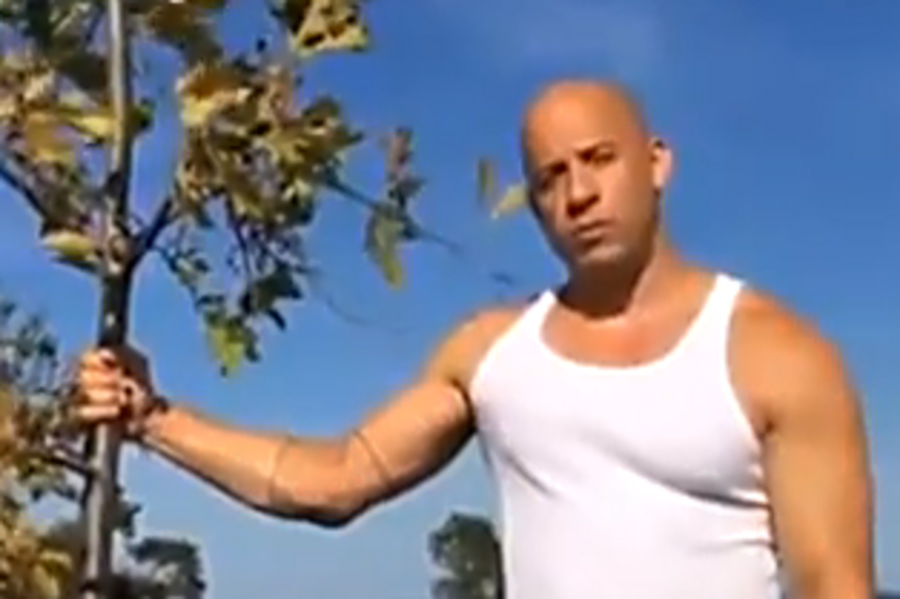Vin Diesel redirects ice bucket challenge: 'Plant a tree for Groot'
Loading...
Does it a take an actor with a fossil fuel surname to save the planet?
Hollywood action star Vin Diesel - a human with hickory hard muscles - is channeling his inner tree. OK, so maybe he's just channeling his latest role, the character of "Groot" in the hit Marvel Comics movie "Guardians of the Galaxy."
Groot is a large, extraterrestrial tree being of immense strength but with limited vocabulary. According to Marvel comics lore, the Flora Colossi have a language that is almost impossible to understand due to the stiffness of their larynxes, causing their speech to sound like they are simply repeating the phrase "I am Groot." Indeed, with one exception, this is Diesel's only line in the "Guardians" film.
Like many celebrities and ordinary mortals, Diesel took the now ubiquitous "Ice Bucket Challenge" but used the attention to redirect to another worthy cause.
On YouTube, Diesel called out Guardians director James Gunn to "plant a tree for Groot." Diesel later posted a photo of himself planting a tree. Gunn accepted the challenge. And so have some of Diesel's Facebook and Twitter followers.
Diesel doesn't provide any horticultural guidance or rationale. But there's at least one reason to plant a tree in the city.
Much like Groot in "Guardians," urban trees may save human lives – just not with as much fanfare.
A study of 10 US cities found that urban trees acted as filters, removing fine particulate pollution from the air.
“More than 80 percent of Americans live in urban areas containing over 100 million acres of trees and forests,” said Michael T. Rains, Director of the US National Forest Service’s Northern Research Station and Acting Director of the Forest Products Lab. “This research clearly illustrates that America’s urban forests are critical capital investments helping produce clear air and water; reduce energy costs; and, making cities more livable. Simply put, our urban forests improve people’s lives.”
The study, “Modeled PM2.5 Removal by Trees in Ten U.S. Cities and Associated Health Effects,” was published last June by the journal Environmental Pollution.
If you're taking up the "Plant a tree for Groot" challenge, what kind of tree should you plant?
Another recent study provides some guidance: Plant a Ginko tree.
The North American climate is changing and the Chicago Botanic Garden looked at what kinds of trees will grow best under the warming scenarios expected over the next 40-65 years.
The federally funded study looked at three climate scenarios developed in 2000 by the Intergovernmental Panel on Climate Change. The study looked at trees likely to thrive in the Chicago metropolitan area in 2020, 2050 and 2080 using such bioclimatic parameters as rainfall in the driest quarter of the year.
The Alliance for Community Trees reports:
Suitable plants under the “worst-case” climate scenario for 2050 were included in the resulting Chicago Botanic Garden Adaptive Planting List. The Autumn Gold Ginkgo (Ginkgo biloba ‘Autumn Gold’) emerged as one of the best performers, rated as suitable for planting along a street side, in a park or residential setting or as a “legacy tree” in a public garden. Fossil records show that the ginkgo – one of the oldest types of trees – once thrived in North America and Europe, but survived in parts of China.
“The ginkgo is now essentially extinct in the wild and grows almost entirely in cultivated landscapes around the world,” said Dr. Andrew Bell of the Chicago Botanic Garden. “It appears to be one of the best-suited trees for a warming urban environment.”
Legacy trees are expected to live more than 60 years, while trees planted in urban parks and residences live an average of 37 to 60 years. “Street trees” growing in a downtown environment have the shortest life expectancy, 13 years. Other trees likely to thrive in a variety of mid-century urban planting conditions are two types of elms that have shown resistance to Dutch Elm’s Disease, the Valley Forge American Elm (Ulmus americana ‘Valley Forge’) and Accolade® Elm (Ulmus ‘Morton Accolade™’), and the Village Green Japanese Zelkova (Zelkova serrata ‘Village Green’).
Go ahead and plant a tree for Groot. But make it a Ginko or a Valley Forge American Elm or a Zelkova.






